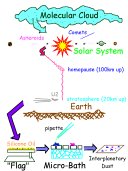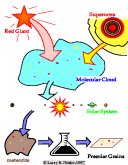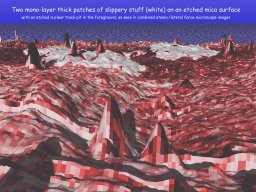

Note: Now that I'm back from the conference,
more related stuff will be posted here soon!/98jan08pf


Since 1980 extraterrestrial bodies directly involved in
the night sky's appearance have been identified on earth. These include
particles from the dust cloud around our sun, collected in the earth's
stratosphere
*cf. Analysis of Interplanetary Dust, AIP Conf. Proc. 310 (eds. Zolensky, Wilson, Rietmeijer & Flynn, Amer. Inst. of Physics, NY, 1994); J. P. Bradley, S. A. Sandford and R. M. Walker, Interplanetary dust particles, in Meteorites and the Early Solar System (eds. J. F. Kerridge and M. S. Matthews), U. Ariz. Press, Tucson AZ, 861-895 (1988); D. E. Brownlee, Cosmic Dust: Collection and Research. Ann. Rev. Earth Planet. Sci. 13 (1985) 147-173; P. Fraundorf, D. E. Brownlee and R. M. Walker, Laboratory studies of interplanetary dust, in Comets (ed. L. Wilkening), U. Ariz. Press, Tucson AZ, 383-409 (1982).
**cf. Astrophysical Implications of the Laboratory Study of Presolar Materials, AIP Conf. Proc. 402, (eds. Bernatowicz and Zinner, Amer. Inst. of Physics, NY, 1997); Zinner E., Interstellar grains from primitive meteorites: New constraints on nucleosynthesis theory and stellar evolution models, in Nuclei in the Cosmos III, (ed. M. Busso, R. Gallino and C. M. Raiteri), AIP, New York, 567-579 (1995). See also the current (Dec '97) Physics Today article on Ancient Stardust in the Laboratory, by T. Bernatowicz and R. M. Walker.

Look forward to the convergence of two exciting new technologies in days ahead. The intense present-day development of virtual reality hardware and software (including ray-tracers like POV-Ray and browser languages like VRML) is designed for the exploration of pretend environments. The Nobel prize winning invention in the 1980's of the scanning tunneling microscope and its proximal probe cousins is, in the 1990's, allowing us to utilize the virtual interfaces mentioned above for the exploration not of pretend, but of real, worlds on the micron and atomic size scales*. It lets all of us, students and researchers alike, become nano-humans. In the near future, you will be able to join your friends in your own Fantastic Voyages, exploring and modifying surface worlds on the size scale of molecules. With your headset on, the surface you see before you as you move around will ripple a bit every few seconds as the scanning probe tip passes by**. We provide examples of this technology, and discuss how the physics that you experience on micron and nanometer scales is likely to differ.
*cf. S. Chaing (editor), Force and tunneling microscopy, Chemical Reviews 97 (4) 1015-1230 (1997)
See an article on the nanoworlds of St. Louis in the 21 Dec 1997 Post-Dispatch. Click here for related pictures. Also, visit our lab page, and some older working notes on recent developments in the field.

This note is about introducing 1-D acceleration in a way that overtly dispels Newtonian misconceptions, thus minimizing the obstacles to a students eventual understanding of curved space-time. Telling students at the outset which quantities depend on the observer's state of motion, and then specifying a map-frame with respect to which such quantities are measured, does the job. The strategy also opens the door to graphical strategies for students freshly introduced to constant acceleration in quantifying motion at any speed. Offering the metric equation as a simple space-time extension of Pythagoras' theorem, written so that traveler-time is the invariant, makes this possible*. Students can then calculate the rate at which things happen on the map from the traveler's point of view. The complications of length-contraction and frame-dependent simultaneity don't arise, as long as only map-frame distances are considered.
Find our table of contents on anyspeed studies here. For a deep understanding of the subject, discover it yourself.
Also find here the paper (submitted to The Physics Teacher and archived/abstracted at LANL as physics/9710013).
*For background, see also physics/9704018.